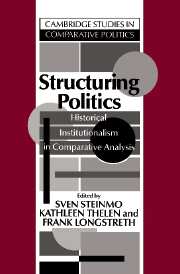Book contents
- Frontmatter
- Contents
- Preface
- List of contributors
- 1 Historical institutionalism in comparative politics
- 2 Labor-market institutions and working-class strength
- 3 The rules of the game: The logic of health policy-making in France, Switzerland, and Sweden
- 4 The movement from Keynesianism to monetarism: Institutional analysis and British economic policy in the 1970s
- 5 Political structure, state policy, and industrial change: Early railroad policy in the United States and Prussia
- 6 Institutions and political change: Working-class formation in England and the United States, 1820–1896
- 7 Ideas and the politics of bounded innovation
- 8 The establishment of work–welfare programs in the United States and Britain: Politics, ideas, and institutions
- Index
1 - Historical institutionalism in comparative politics
Published online by Cambridge University Press: 04 August 2010
- Frontmatter
- Contents
- Preface
- List of contributors
- 1 Historical institutionalism in comparative politics
- 2 Labor-market institutions and working-class strength
- 3 The rules of the game: The logic of health policy-making in France, Switzerland, and Sweden
- 4 The movement from Keynesianism to monetarism: Institutional analysis and British economic policy in the 1970s
- 5 Political structure, state policy, and industrial change: Early railroad policy in the United States and Prussia
- 6 Institutions and political change: Working-class formation in England and the United States, 1820–1896
- 7 Ideas and the politics of bounded innovation
- 8 The establishment of work–welfare programs in the United States and Britain: Politics, ideas, and institutions
- Index
Summary
The “rediscovery” of institutions has opened up an exciting research agenda in comparative politics and comparative political economy. Scholars working in different disciplines and writing on subjects as diverse as the political economy of advanced capitalism and policy-making during China's Great Leap Forward have all focused on the significance of institutional variables for explaining outcomes in their respective fields. Within comparative politics, “new” institutionalism has been especially associated with leading students of comparative political economy such as Suzanne Berger, Peter Hall, Peter Katzenstein, and Theda Skocpol, among others. Although it has now been around for several years, few have stepped back to analyze the distinctive features of the kind of historical institutionalism these theorists represent, nor to assess its strengths and overall contribution to comparative politics. These are themes we take up in this introductory chapter.
The chapter proceeds in three steps. We begin with a brief discussion of the building blocks of this approach: how institutions are defined and how they figure into the analysis. Second, we sketch the characteristic features of historical institutionalism and the broader theoretical project that animates institutional analyses. New institutionalists draw inspiration and insights from older traditions in economics, political science, and sociology. But renewed, explicit attention to institutional variables since the late 1970s grew out of a critique of the behavioral emphasis of American and comparative politics in the 1950s and 1960s, which – although it drew attention to other important and previously neglected aspects of political life – often obscured the enduring socioeconomic and political structures that mold behavior in distinctive ways in different national contexts.
- Type
- Chapter
- Information
- Structuring PoliticsHistorical Institutionalism in Comparative Analysis, pp. 1 - 32Publisher: Cambridge University PressPrint publication year: 1992
- 532
- Cited by



